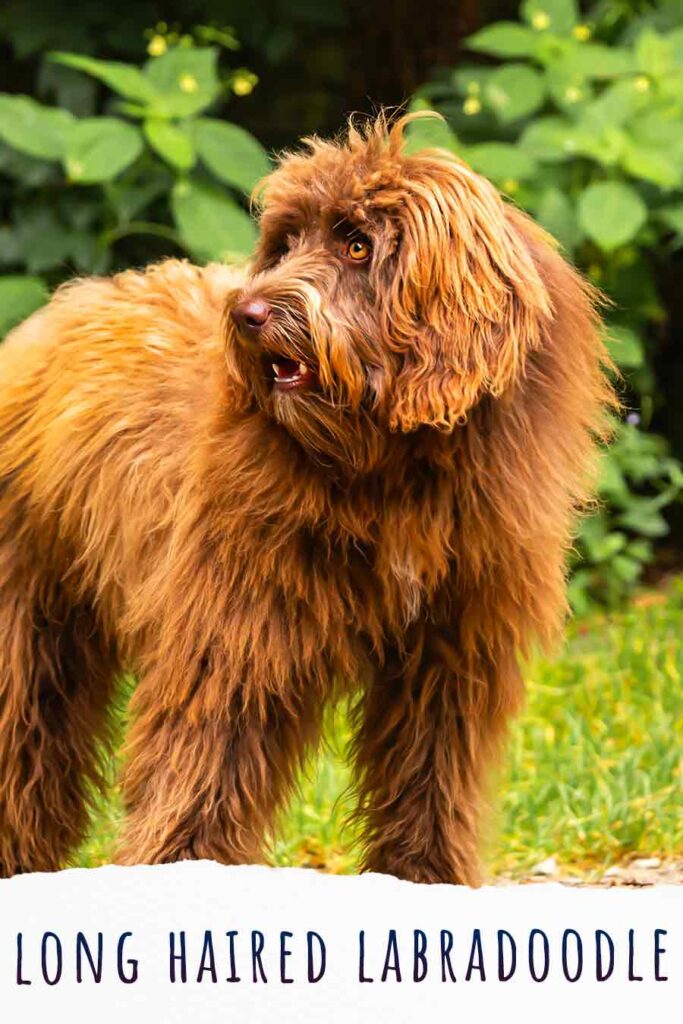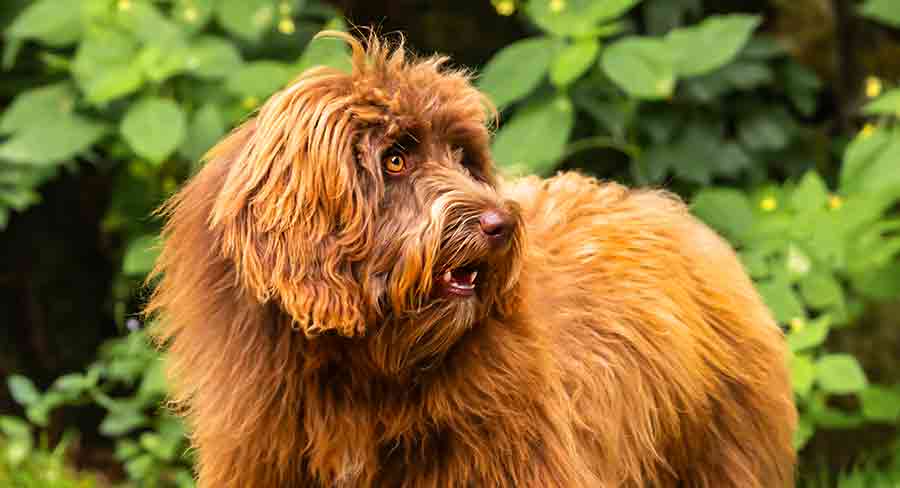A long haired Labradoodle is not a common sight, since many owners will trim their dog’s coat regularly! But, it is possible for Labradoodles to have long coats. Long fur will require much more intense grooming routines, whether it’s the hair, fleece, or wool type. And, any knots and tangles that are left alone can become very painful for your dog. So, it’s not a good idea to let your Labradoodle’s fur grow long if you are not prepared to groom them at least once a day.
About Labradoodle Hair
As a mixed breed, Labradoodle dogs can inherit any traits from either parent breed. The Labrador Retriever and Poodles genes have combined to make three common fur types across the Labradoodle breed. Breeders won’t know exactly what fur type a litter of puppies will have until they arrive. Some might not be able to tell you the exact type until the puppy has started to shed its puppy coat, which can take months. But, many breeders specialize in certain coat types. So, what are those three common hair types?
Hair Coat
The Labradoodle hair coat is the most similar to the Labrador parent. This coat type often consists of two layers. The fur will be straight in appearance. It will also be dense, and quite coarse to the touch, like a Lab’s coat. It is water resistant, and usually heavy shedding. This coat type is the least popular with people who suffer from allergies, or who want to minimize the amount of dog fur around the house.
Fleece Coat
The Labradoodle fleece coat is the perfect middle ground between the two parents. The exact amount of curl will vary from soft waves to loose curls. Whilst some Doodles may have double layered fleece coats, a single layer is more common. The amount of shedding will also vary. Fleece coats are very soft to the touch, and are the most popular Labradoodle coat!
Wool Coat
And finally, the Labradoodle wool coat! This fur type is the most like the Poodle parent. It will be either very tight curls, or dreadlocks. Wool coats feel coarse to the touch and have the highest grooming requirements of all three coat types. This is because those tight curls catch any shedding fur. So, you’re unlikely to see much loose hair around the house! Wool coat Labradoodles are therefore very popular with owners that have allergies.
Can Labradoodles Grow Long Hair?
No matter which of the three coat types your Labradoodle has, they can grow long hair! Generally, those with the hair coat are the most likely to have short fur, but even they can have potentially long coats. The reason you see so many Labradoodles with short hair is simply because owners trim the coats to make grooming easier.
Poodle coats grow continuously throughout their lives. So, many Poodles require regular trims. Most Labradors do not share this trait. Labradors tend to have short, dense coats that shed heavily, but do not grow excessively long. However, long haired Labradors exist! They’re very uncommon, as this trait is only expressed when Labs inherit two copies of a recessive gene – the fibroblast growth factor 5 gene, more often known as FGF5 or simply the L gene.
Mixing a Poodle with a long haired Labrador will increase your chances of getting puppies with long fur. But, generally, Labradoodles tend to inherit the Poodle trait of continuously growing hair, especially if they have fur or wool type coats.

Grooming a Long Haired Labradoodle
The main reason people choose to keep their Labradoodle’s fur trimmed is because it is easier to maintain. Shorter fur is less prone to knots and tangles, and easier to brush. Since it gets fewer tangles, owners can wait slightly longer between brushes, too.
Grooming needs and techniques will vary depending on the type of fur your Labradoodle has. Hair type coats have the lowest grooming requirements, but still much be brushed each week, especially if your hair Labradoodle has long fur. Fleece and wool coat types are much more labor intensive when it comes to grooming.
Grooming a Long Haired Fleece Labradoodle
Fleece coats need more grooming than hair coats, but again the technique will vary depending on whether or not it is a single or double layer, and how tightly curled the waves are. A long haired fleece Labradoodle coat will have a generally shaggy appearance. It will be much more prone to tangles than a short fleece coat.
A long haired fleece Doodle will likely need to be brushed at least once a day. They will also likely need more in-depth grooming sessions every couple of weeks, if not more frequently.
Grooming a Long Haired Wool Labradoodle
Wool Labradoodle coats are the most time consuming to groom, and require grooming the most often. The fur is very tightly curled, and is therefore very prone to tangles and knots. If left alone, these will matte and become very painful for your dog, tugging on their skin.
Wool coat Labradoodles with long hair will need to be brushed multiple times a day – at least once in the morning and once at night, to eliminate any knots before they start hurting your dog. More in-depth grooming sessions will likely be required once a week.
Why Do Long Haired Labradoodles Need So Much Grooming?
Long haired Labradoodles will need more grooming than short haired versions because their long fur is more likely to tangle. Tangles and knots in your Labradoodles coat can be really uncomfortable and painful for your dog. And, they won’t be very nice to look at! If left too long, your dog’s entire coat can matte together. When this happens, most professional dog groomers would recommend shaving your dog’s fur altogether to fix it.
Short haired Labradoodles are simply easier to care for. Unless you have lots of time each day to dedicate to grooming, long haired Labradoodle care isn’t feasible. And, longer fur can be problematic for Labradoodles playing or exercising outdoors, as things are more likely to get caught and stuck in their fur.
Are Long Haired Labradoodles Hypoallergenic?
No dog breed is truly hypoallergenic. This is because allergens that cause allergy symptoms can be found in dander and saliva. The more curly your dog’s coat is, the more likely it is to catch dander and saliva-coated hairs before they drop around your house. So, wool coats are often the most popular with allergy sufferers.
However – it’s important to remember that wool coats require the most grooming. This means, you’ll be up close to those allergens! And, long haired Labradoodles require more grooming than short haired versions. So, you’ll be in contact with dander and saliva-coated hairs even more than you would be otherwise. Unless someone else in the family is happy to do all of that grooming for you, it may be best to keep your Doodle’s hair short and more manageable.
Finding a Long Haired Labradoodle
Long haired Labradoodles aren’t common, since shorter hair is easier to maintain. Hair coat Labradoodles may inherit the short fur of the Labrador. But, occasionally you’ll find a hair coat Doodle whose fur can grow longer. Long fur is more common for fleece and wool types. But, again, it’s unlikely you’ll see this until your Doodle is older.
All Labradoodle puppies are born with a similar single layered puppy coat. This sheds in time to reveal their adult coat. Once they have their adult coat, it will likely take a few weeks to see considerable hair growth. Most owners choose to get their Doodle’s coat trimmed every 6 to 8 weeks. So, just increase the length between groomer trips if you’d like your Labradoodle to have longer hair – for instance, wait for 12 weeks. But, remember that long fur requires a lot of grooming. You can’t just leave it because you can’t be bothered – those knots are inevitable and can cause your dog some serious pain and discomfort.
Do You Have a Long Haired Labradoodle?
Do you like to let your Labradoodle’s hair grow longer between grooming trips? Grooming sessions can be a great way to bond with your dog. So, some people will enjoy the extra time they get to spend grooming their long haired Labradoodle! But, it’s not a suitable option for a lot of owners. Let us know your experiences with Labradoodle hair in the comments!
Readers Also Liked
- Do Mini Labradoodles Shed?
- Do Labradoodles Need a Winter Coat?
- Fluffy Labradoodle
- Big Labradoodle
- Labradoodle Hair Types
- Flat Coated Labradoodle
References and Resources
- Ali, M. (et al), ‘Genetic Analysis of the Modern Australian Labradoodle Dog Breed Reveals an Excess of the Poodle Genome’, Plos Genetics (2020)
- Housley, D. & Venta, P. ‘The Long and the Short of it: Evidence that FGF5 is a Major Determinant of Canine ‘Hair’-itability’, Animal Genetics (2006)
- Vredegoor, D. (et al), ‘Can f 1 Levels in Hair and Homes of Different Dog Breeds: Lack of Evidence to Describe Any Dog Breed as Hypoallergenic’, Journal of Allergy and Clinical Immunology (2012)
- Nicholas, C. (et al), ‘Dog Allergen Levels in Homes with Hypoallergenic Compared with Nonhypoallergenic Dogs’, American Journal of Rhinology & Allergy (2011)

